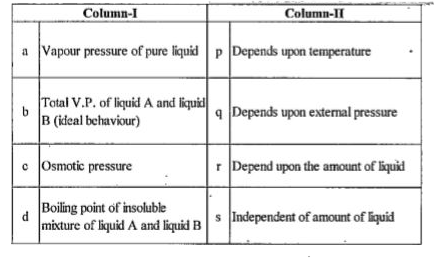The mass of glucose that should be dissolved in 50g of water in order to produce the same lowering of vapour pressure as is produced by dissolving 1g of urea in the same quantity of water isSolution in Malayalam
The correct Answer is:3
(Δp)glucose=(Δp)ureaand(xB)glucose=(xB)urea
∵ amoutn of water is the same (nB) urea = (nB) glucose
i.e, (nBnA)glucose=(nBnA)ureaorw−(B)50×18180=1×1850×60,wB=3g
Topper's Solved these Questions
- SOLUTIONSBOOK - BRILLIANT PUBLICATIONCHAPTER - SOLUTIONSEXERCISE - Level-III (Matching Column Type)
5 Videos
- SOLUTIONSBOOK - BRILLIANT PUBLICATIONCHAPTER - SOLUTIONSEXERCISE - Level-III (Statement Type)
6 Videos
- SOLUTIONSBOOK - BRILLIANT PUBLICATIONCHAPTER - SOLUTIONSEXERCISE - Level-III (Multiple Correct Answer Type)
11 Videos
- SOLID STATEBOOK - BRILLIANT PUBLICATIONCHAPTER - SOLID STATEEXERCISE - LEVEL-3 (Linked Comprehension Type)
10 Videos
- STEREOCHEMISTRY BOOK - BRILLIANT PUBLICATIONCHAPTER - STEREOCHEMISTRY EXERCISE - LEVEL-II (ASSERTION - REASON TYPE)
2 Videos
Similar Questions
Match the columns

View SolutionStatement 1: Two sucrose solutions of same molality prepared in different solvents will have the same freezing point depression
Statement 2: Different solvents will have different value of Kf
View SolutionWhich of the following statements are correct ?
View SolutionF centre is an example of metal excess defect due to the presence of extra cations at interstitial sites. Zinc oxide is white in colour at room temperature, on heating it loses oxygen and turns yellow.
ZnOHeat−−→Zn2++12O2+2e−
Now there is excess of zinc in the crystal and its formula becomes Zn1+x O. the excess of Zn2+ ions move to interstitial sites and the electrons to neighbouring interstitial sites.
There are many solids which are difficult to prepare in the stiochiometric composition and contain less amount of the metal as compared to stiochiometric proportion. a typical example of this type is FeO which is mostly found with a composition of Fe0.95. it may actually range from Fe0.96 O.
Q. In Fe0.95 O:
View SolutionAssertion : Meso tartaric acid is optically inactive
Reason : Meso tartaric acid has a plane of symmetry
View Solution12g of a nonvolatile solute dissolved in 108g of water produces the relative lowering of vapour pressure of 0.1. The molecular mass of the solute is
View SolutionWhat weight of glucose dissolved in 100 grams of water will produce the same lowering of vapour pressure as one gram of urea dissolved in 250 grams of water, at the same temperature ?
View SolutionWhat weight of glucose dissolved in 100g of water will produce the same lowering of vapour pressure as one gram of urea dissolved in 50g of water at the same temperature
View Solution3g urea is dissolved in 45g of water. The relative lowering of vapour pressure is :
View Solution18.2 g of urea is dissolved in 100g of water at 50∘C. The lowering of vapour pressure produced is 5 mm Hg. Calculate the molecular mass of urea. The vapour pressure of water at 50∘C is 92 mm Hg.
View Solution6g of urea is dissolved in 90g of water. The relative lowering of vapour pressure is equal to
View SolutionThe relative lowering of vapour pressure produced by dissolving 71.5 g of substance in 1000g of water is 0.0173. The molecular mass of the substance will be:
View SolutionThe relative lowering of vapour pressure produced by dissolving 71.5 g of a substance in 1000 g of water is 0.00713. The molecular mass of the substance will be:
View SolutionWhat weight of glucose dissolved in 100g of water will produce the same lowering of vapour pressure as one gram of urea dissolved in 50g of water at the same temperature
View SolutionWhat weight of glucose dissolved in 100g of water will produce the same lowering of vapour pressure as one gram of urea dissolved in 50g of water at the same temperature
View Solution50g জলে Wg গ্লুকোজ দ্রবীভূত করলে প্রাপ্ত দ্রবণের বাস্পচাপের যে আপেক্ষিক অবনমন ঘটে, তা সমপরিমান জলে 1g ইউরিয়া দ্রবীভূত করে প্রাপ্ত দ্রবণের বাস্পচাপের আপেক্ষিক অবনমনের সমান হয়। W-এর মান
View Solution
